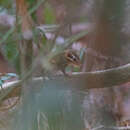en
names in breadcrumbs


Perception Channels: tactile ; chemical
Not too well known, but D. murina seem to be abundant
(von Holst, 1990).
US Federal List: no special status
CITES: no special status
IUCN Red List of Threatened Species: least concern
The diet of northern smooth-tailed tree shrews consists mostly of fruit, arthropods, and small vertebrates. The digestive tracts of D. murina are very simple, which allows them to pass food very fast. This means that they must eat basically all day long to maintain their energy (Eckstrom, 1996).
Animal Foods: mammals; amphibians; reptiles; insects; terrestrial non-insect arthropods
Plant Foods: fruit
Primary Diet: omnivore
Northern smooth-tailed tree shrews are distributed in eastern India, Southeast Asia, and on some of the Malaysian islands (von Holst, 1990).
Biogeographic Regions: oriental (Native )
Dendrogale murina resides in tropical forests with elevations up to 1500 m above sea level.
Range elevation: 0 to 1500 m.
Habitat Regions: tropical
Terrestrial Biomes: rainforest
In captivity D. murina live 9 to 10 years, but in the wild they can live to a little over 12 years (von Holst, 1990).
Range lifespan
Status: wild: 12 (high) years.
Typical lifespan
Status: captivity: 9 to 10 years.
Dendrogale murina is the smallest of 19 species in the order Scandentia. The head-body length is 11.5 cm, with a tail length of 4 to 5 cm, weighing in at approximately 35 to 55 g. They are light in color and have facial markings, which are used to distinguish between the other smooth-tailed shrew (Dendrogale melanura), which lacks these facial markings.The upper body is brown/blackish in color, while the underside is lighter. They are short-haired and lack shoulder stripes. The tail is dark and becomes increasingly darker as it nears the tip. This species has relatively small claws (Nowak and Paradiso, 1983).
Range mass: 35 to 55 g.
Other Physical Features: endothermic ; bilateral symmetry
Dendrogale murina tend to breed when fruiting of local trees and shrubs is at its maximum (Blomstrom, 2001). Their weaning time is about 30 days and they usually give birth to twins. Infant Northern Smooth-tailed Tree Shrews are born weighing 6 to 10 g and are hairless, blind, and totally dependent on the mother. The mother lactates from just two nipples. The mother's milk is very high in fat content. On average a pair of these shrews mate and produce young every 45 days. Dendrogale murina reach sexual maturity after 2 months. Once sexual maturity has reached, the young are forced out of the nest; they live on their own until they find a suitable mate (von Holst, 1990).
Average number of offspring: 2.
Average weaning age: 30 days.
Average age at sexual or reproductive maturity (female): 2 months.
Average age at sexual or reproductive maturity (male): 2 months.
Key Reproductive Features: gonochoric/gonochoristic/dioecious (sexes separate); sexual ; viviparous
Parental Investment: altricial
The northern smooth-tailed treeshrew (Dendrogale murina) is a species of treeshrew in the family Tupaiidae found in Cambodia, Thailand, and Vietnam.[2] Their diet primarily consists of invertebrates but rarely includes fruits and plants.[4]
The northern smooth-tailed treeshrew (Dendrogale murina) is a species of treeshrew in the family Tupaiidae found in Cambodia, Thailand, and Vietnam. Their diet primarily consists of invertebrates but rarely includes fruits and plants.